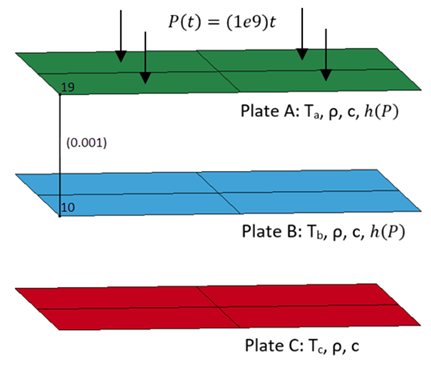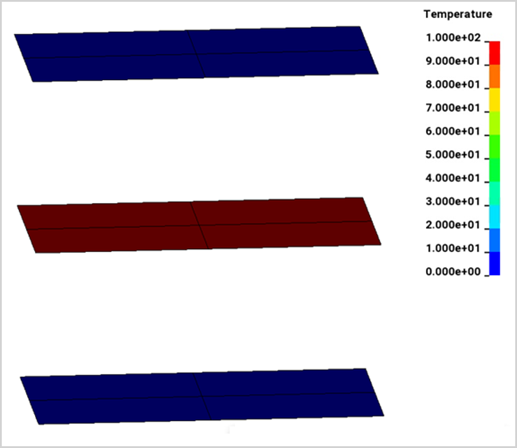VM-LSDYNA-SOLVE-011
VM-LSDYNA-SOLVE-011
Transient Linear Thermal Structural Analysis
Overview
| Reference: | Kreith, F. (1959). Principles of Heat Transfer (2nd ed.). International Textbook Co. |
| Analysis Type(s): | Transient Linear Thermal Structural |
| Element Type(s): | Shell |
| Input Files: | Link to Input Files Download Page |
Test Case
Three plates, each 0.001 m thick, are stacked on top of each other. The bottom plate C is constrained in all translational degrees of freedom. The top plate A is constrained in x and y translation. The displacement of the middle plate B is constrained in the x-direction on one edge and in the y-direction on the adjacent edge. Each plate has a thermal density ρ = 1kg/m3 and specific heat c = 1 J/kg°C.
The top and bottom plates have constant temperatures of 0°C, while the middle plate has an initial temperature of 100°C. The top and bottom plates have constant static and dynamic friction coefficients with respect to temperature of 0.3 and 0.4, respectively.
A linearly increasing pressure load is applied to the top surface according to the equation:
The contact conductance between the middle and top plate is a function of the interface pressure according to the equation:
Find the transient temperature Tb of the middle plate 0.02 seconds into loading.
| Material Properties | Geometric Properties | Loading |
|---|---|---|
| l = 0.001 m | ρ = 1kg/m3 | P(t) = (1e9)t |
| – | c = 1 J/kg°C | Ta = Tc = T∞ = 0°C |
| – | h(P) = (5e-6)P | Tb-initial = 100°C |
Analysis Assumptions and Modeling Notes
LS-DYNA Thermal Solver 3 is used. ATYPE is set to 1 in *CONTROL_THERMAL_SOLVER to establish transient analysis. SOLN is set to 2 in *CONTROL_SOLUTION to specify coupled structural thermal analysis. The plates are modeled as shells with ELFORM 1 and thickness 0.001 m. Translational constraints are made using the *NODE keyword. Temperature boundary constraints and initial temperatures are made with *BOUNDARY_TEMPERATURE and *INITIAL_TEMPERATURE, respectively.
The top plate pressure load is applied using *LOAD_SEGMENT. Contact between the middle and bottom plate is established with *CONTACT_SURFACE_TO_SURFACE. Contact between the top and middle plate is established using *CONTACT_SURFACE_TO_SURFACE_THERMAL_FRICTION, where the static and dynamic friction coefficients with respect to temperature are specified. This keyword also defines the thermal contact conductance as a function of temperature and pressure between the top and middle plate. *LOAD_SURFACE_STRESS is specified so contact pressure between shell elements will be calculated.
Combining the contact conductance as a function of pressure and the pressure as a function of time, we obtain the heat transfer coefficient as a function of time:
The rate of heat flow out of the body can be described by the control volume energy balance:
An alternate form of the equation with the heat transfer coefficient as a function of time can be written as:
Having performed the separation of variables and having integrated temperature T (from 100°C to Tb) and time t (from 0 to 0.02 s) gives the analytical solution Tb = 36.788°C.





